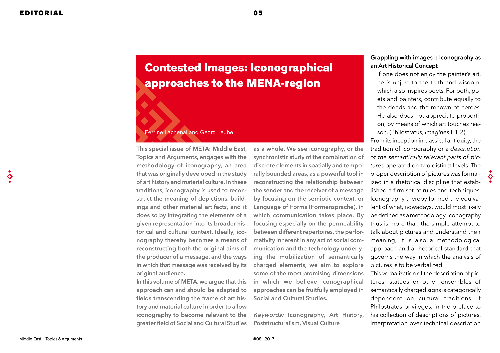Contested Images: Iconographical Approaches to the MENA-region
This special issue of META: Middle East, Topics and Arguments, engages with the methodology of iconography, an area that was originally developed in the study traditions, iconography is used to reconstruct the meaning of depictions, buildings and other material artifacts, and it does so by integrati...
Gespeichert in:
| Veröffentlicht in: | Middle East - Topics & Arguments |
|---|---|
| Autoren: | , |
| Format: | Artikel (Zeitschrift) |
| Sprache: | Englisch |
| Veröffentlicht: |
Philipps-Universität Marburg
2017
|
| Schlagworte: | |
| Online Zugang: | Online Zugang |
| Tags: |
Tag hinzufügen
Keine Tags, Fügen Sie den ersten Tag hinzu!
|
| Zusammenfassung: | This special issue of META: Middle East, Topics and Arguments, engages with the methodology of iconography, an area that was originally developed in the study traditions, iconography is used to reconstruct the meaning of depictions, buildings and other material artifacts, and it does so by integrating the elements of a given representation into its broader historical and cultural context. Ideally, iconography thereby becomes a means of reconstructing both the original aims of the producer of a message, and the ways in which that message was received by its original audience.In this volume of META, we argue that this approach can and should be adapted to fields transcending the frame of art history and material culture in order to allow greater field of Social and Cultural Studies as a whole. We see iconography, or the synchronistic study of the combination of discrete elements in spatially and temporally bounded areas, as a powerful tool in reconstructing the relationship between the sender and the receiver of a message by focusing on the semiotic context, or Language of Forms (Formensprache), in which communication takes place. By focusing especially on the permeability between different repertoires, the performativity inherent in any act of social communication and the technology underlying the mobilization of semantically charged elements, we aim to explore some of the most promising dimensions in which we believe iconographical approaches can be fruitfully employed in Social and Cultural Studies. |
|---|---|
| DOI: | 10.17192/meta.2017.8.6964 |
 Publikationsserver
Publikationsserver